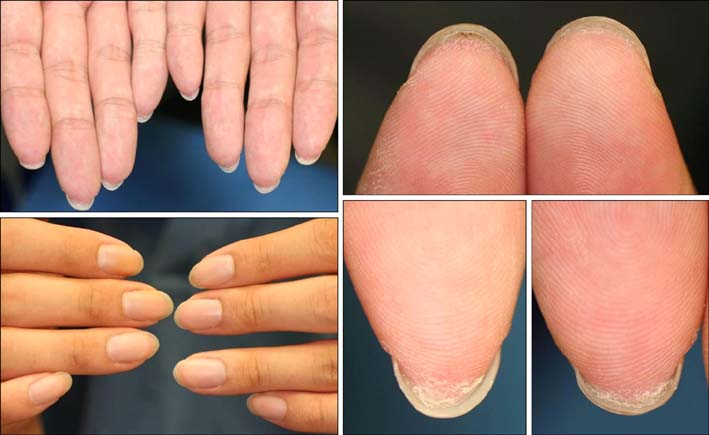Ann Dermatol.
2014 Jun;26(3):374-376.
A Case of Acquired Idiopathic Pterygium Inversum Unguis
- Affiliations
-
- 1Department of Dermatology, Seoul St. Mary's Hospital, College of Medicine, The Catholic University of Korea, Seoul, Korea. jylee@catholic.ac.kr
Abstract
- Pterygium inversum unguis (PIU) is a rare nail abnormality in which the distal nail bed adheres to the ventral surface of the nail plate, with obliteration of the distal groove. Because of the rarity of this condition, its exact origin is unknown. This disorder can be either congenital or acquired, with or without a family history. The acquired forms may be idiopathic or secondary to systemic connective tissue diseases or other causes such as stroke, neurofibromatosis, leprosy, or the use of nail fortifiers. We present an unusual case of acquired idiopathic PIU of the 10 fingernails in a 22-year-old man.
Keyword
MeSH Terms
Figure
Reference
-
1. Nogita T, Yamashita H, Kawashima M, Hidano A. Pterygium inversum unguis. J Am Acad Dermatol. 1991; 24:787–788.
Article2. Vadmal M, Reyter I, Oshtory S, Hensley B, Woodley DT. Pterygium inversum unguis associated with stroke. J Am Acad Dermatol. 2005; 53:501–503.
Article3. Caputo R, Prandi G. Pterygium inversum unguis. Arch Dermatol. 1973; 108:817–818.
Article4. Odom RB, Stein KM, Maibach HI. Congenital, painful, aberrant hyponychium. Arch Dermatol. 1974; 110:89–90.
Article5. Patterson JW. Pterygium inversum unguis-like changes in scleroderma. Report of four cases. Arch Dermatol. 1977; 113:1429–1430.
Article6. Catterall MD, White JE. Pterygium inversum unguis. Clin Exp Dermatol. 1978; 3:437–438.
Article7. Morimoto SS, Gurevitch AW. Unilateral pterygium inversum unguis. Int J Dermatol. 1988; 27:491–494.
Article8. Caputo R, Cappio F, Rigoni C, Scarabelli G, Toffolo P, Spinelli G, et al. Pterygium inversum unguis. Report of 19 cases and review of the literature. Arch Dermatol. 1993; 129:1307–1309.
Article9. Balma A, Pope E. Acquired idiopathic pterygium inversum unguis. Clin Pediatr (Phila). 2010; 49:394–395.
Article10. Oiso N, Narita T, Tsuruta D, Kawara S, Kawada A. Pterygium inversum unguis: aberrantly regulated keratinization in the nail isthmus. Clin Exp Dermatol. 2009; 34:e514–e515.
Article11. Paley K, English JC 3rd, Zirwas MJ. Pterygium inversum unguis secondary to acrylate allergy. J Am Acad Dermatol. 2008; 58:S53–S54.12. Daly BM, Johnson M. Pterygium inversum unguis due to nail fortifier. Contact Dermatitis. 1986; 15:256–257.
Article13. Patki AH. Pterygium inversum unguis in a patient with leprosy. Arch Dermatol. 1990; 126:1110.
Article


